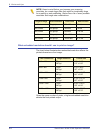
DocuColor 8000/7000 Operator Manual
9-2
9. Hints and tips
Definition of SEF and LEF
SEF (short edge feed) refers to the shorter edge of a document as
the first edge to contact the Document Feeder rolls; for example,
the 8.5 inch side of an 8.5 x 11 inch document.
LEF (long edge feed) refers to the longer edge of a document as
the first edge to contact the Document Feeder rolls; for example,
the 11 inch side of an 8.5 x 11 inch document.
The page feed and orientation controls are only used to describe
to the scanner how the original image has been loaded into the
document feeder. They have no bearing on how your image is
oriented (landscape or portrait) when printed.
The SEF/LEF toggle buttons and the Rotate A button (Advanced
Scanning) have no relationship to final image orientation. When
properly set, they simply ensure that when previewing, your image
appears upright in the Preview window.
NOTE: When scanning large numbers of documents from the
Document Feeder, arrange them LEF to achieve faster throughput
speed.
Guide to choosing an Original Type for your scan
Use the following table to help you choose which Original Type
(Advanced Scanning) to choose for your original documents:
LEF
SEF
If your original is: Choose
A mixed batch of originals, of different
type or of multiple types per page, such
as halftones with text
Automatic
A photograph or continuous tone image,
or a very high frequency halftone with a
screen frequency higher than 200 lpi, or a
mix of several types of images
Photograph
A halftone with a screen frequency
between 112 and 200 lpi
Fine Halftone
A halftone less than 112 lpi Coarse Halftone
Text or line art Text
A mix of coarse halftones and text, such
as found in a newspaper
Coarse Halftone & Text
(Laser Print)
A mix of fine halftones and text, such as
found in magazines
Fine Halftone & Text
(Magazine)
A mix of photographs and text. (For this
purpose, treat halftones with a screen
frequency higher than 200 lpi as
photographs.)
Photograph & Text
(Paste-up)


















